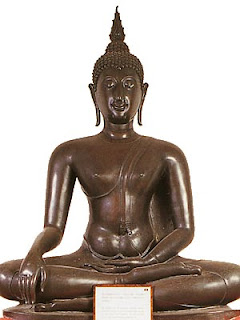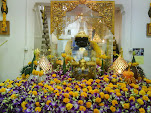 In the 14th century A.D, King Sri Indrathit declared Sukhothai’s liberation from the Khmer and adopted a form of Buddhism based on the Sri lanka School. During this time, Sukhothai Art developed a radically different appearance to Mon and Khmer styles.
In the 14th century A.D, King Sri Indrathit declared Sukhothai’s liberation from the Khmer and adopted a form of Buddhism based on the Sri lanka School. During this time, Sukhothai Art developed a radically different appearance to Mon and Khmer styles.The difference can be seen in the "Walking Buddha" an original creation of the Sukhothai School. The inspiration which developed the idea of idealistic and superhuman characteristic and expressed the power of compassion and serenity. Such developement have made Sukhothai Art worthy of high praise as a truly unique and beautiful style. It was also during this period that the "four postured" group of Buddha images were created. The 4 poses consisted of, walking, standing, sitting and reclining. Sukhothai images can be classified into four distinct groups.
- The major Group: Distinguished Sukhothai features include a flame aureole, whorls of fine curled hair, an oval facem high curving eyebrows, downward gazing eyes, booked nose and a gentle smiling expression. The torso included broad shoulders and a small waist. Robes were hung diagonally across the body and were completed with a zigzag edged mantle that extended down to the navel, seated in the Subduing Mara posture on a plain base.
- The Kamphaengbet Group: The characteristics are generally similar to the major group apart from a broader upper face and a pointed chin.
- The Phra Putthachinaraj group: In this group, thought to have originated during the reign of King Lithai, the aureole is flame shaped, the torso is rather plump, the face rounded and all fingers ( excluding the thumb) on each hand were of equal length.
- The Heterogeneous Group or Wat Ta Kuwan Group: First discovered at Wat Ta Kuan in Sukhothai. The facial features are similar to images from the early Chiang Saen – Lanna period. This style is thought to have been created during the early 14th century A.D.
胡


No comments:
Post a Comment